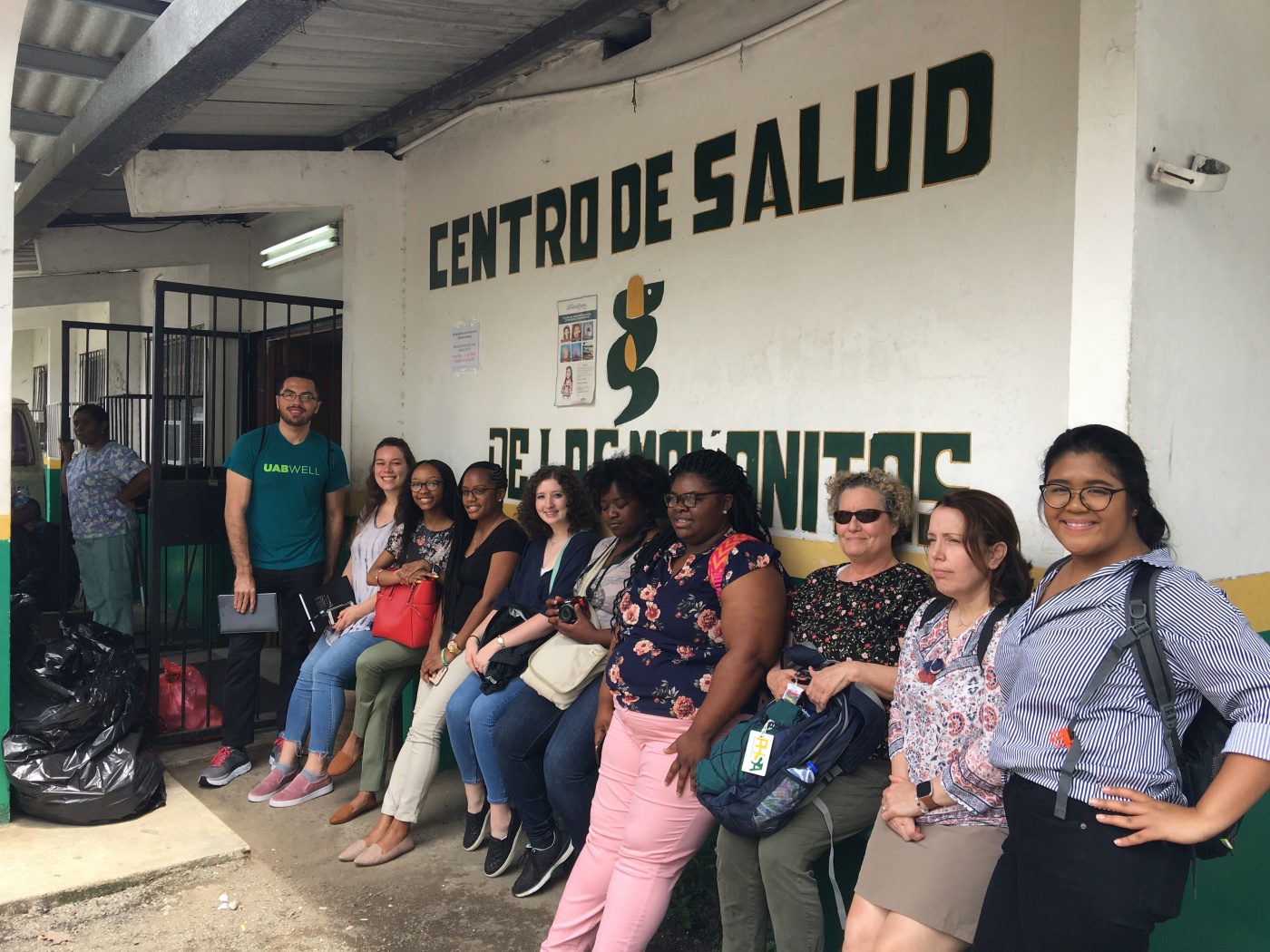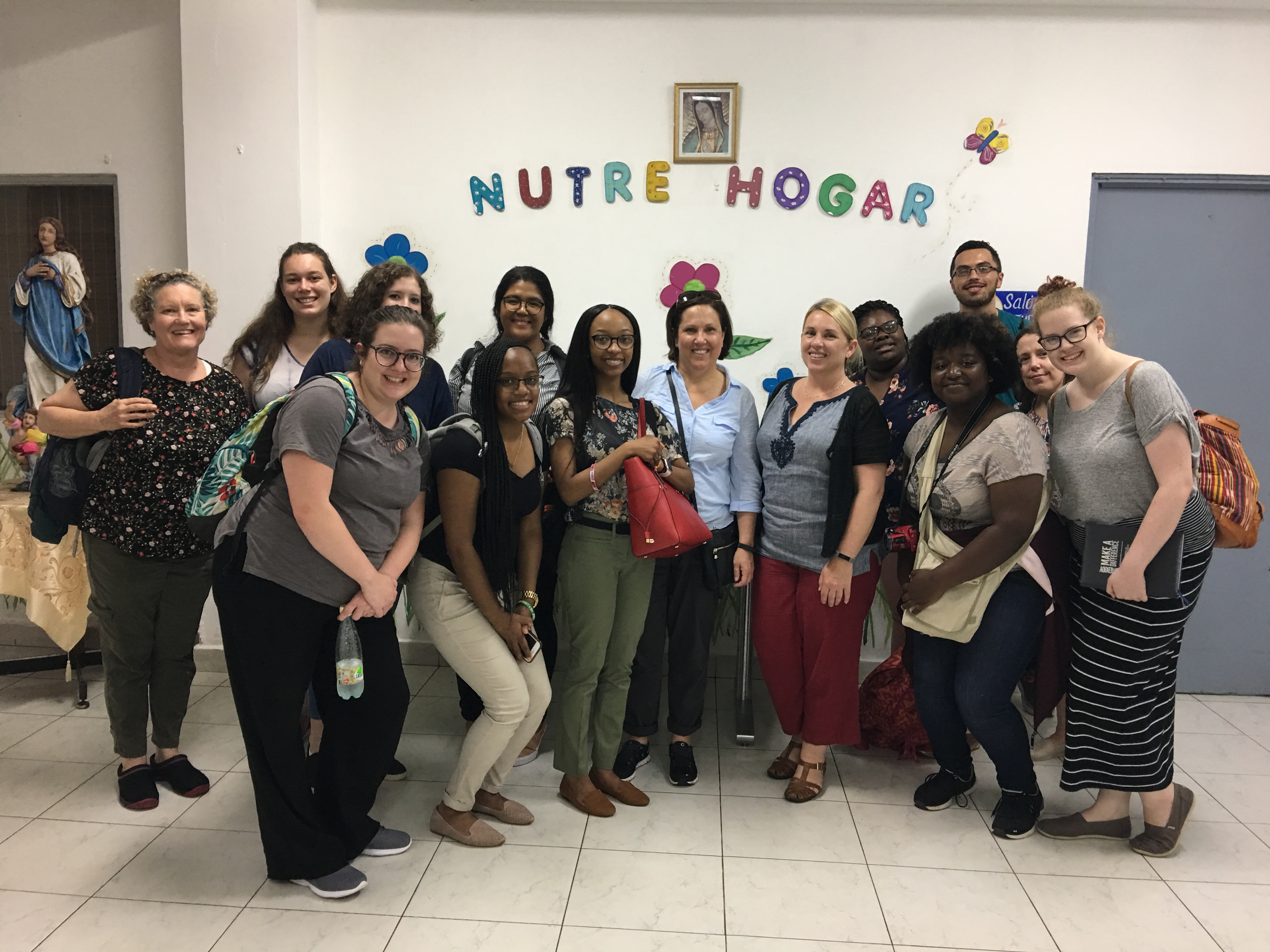
Las Mañanitas Health Center
Today’s visit focused on Las Mañanitas Health Center, a clinic with 58 employees including administration, servicing over 60,000 people within the district of Mañanitas that lies just outside Panama City. (The national health system is divided into 26 districts, each with its own health center.) Las Mañanitas Health Center was established in 1989 and will soon be replaced by a new 2-story facility to meet the needs of the growing population in the area. Within this community, most of the people do not work enough hours to be able to contribute and participate in Panama’s social security program or pay for private insurance, so this public health clinic is the primary outlet for this population to access health services. Appointments must be made, so there are often lines starting at 5:00 AM when the clinic opens to secure a spot on the roster. To provide additional context, when the clinic was established, there were approximately 25,000 people living in Mañanitas, but the area’s population has grown rapidly without any planned infrastructure or public services. Currently at the health center, there are two pediatricians, who often each see 16-18 patients a day and a general practitioner who may see up to 28 patients a day.
As Las Mañanitas Health Center is a Ministry of Health health center, services are provided at no charge or a low cost to patients of all nationalities. This can be challenging when establishing specific health programs or initiatives due to varied cultural norms– an example given was in regard to littering in the street. However, providing preventative health care to all is vital since Panama is a hub for travel and trade there are a myriad of infectious diseases that come through the country. There are simply insufficient financial and human resources to aggressively fight pandemics in Panama.
Care is available to all age groups. Prevention starts early and children ages 0-5 are always seen free of charge and provided with vaccines, dental, and nutritional services beginning when the child is 8 days old. Vaccination is obligatory for families, and should a parent not comply, punitive action may be taken by the state. Teens are offered programs both within the clinic and within the school setting regarding consultation and education with behavioral health such as drug use or sex practices. Panama’s population is also aging and with that comes a need to address the quality of life of the population. It is not uncommon for grandparents to take care of grandchildren and delay seeking care for their own health issues. The clinic offers weekly classes or seminars on a given topic to help educate the elders within the community about the issues they may face, as well as provide a safe space to engage with each other, participate in handicrafts, etc.
Vector Control
Panama has a long history with vector control going back to the elimination of yellow fever and the control of malaria during the Panama Canal construction, and Las Mañanitas vector control unit is carrying on this tradition. Las Mañanitas’ comprehensive public health unit includes vector control, sanitation, epidemiology, and food safety. Today, we met with vector control specialists who told us more about the work they do and took us into the community to observe their surveillance and assessment methods. Much of what the vector control unit does involves checking homes for mosquito breeding grounds, identifying standing water and eliminating these breeding grounds.

The disease they are currently working to prevent is Dengue Fever. If a person goes into the health clinic with symptoms of Dengue Fever, then the vector control unit visits that person’s home the next day and fumigates everything within a 500-meter radius. Within that radius, breeding grounds are identified and the radius is expanded to 500 meters around where each breeding ground is located. This strategy is very effective and is one of the reasons why Panama has lower rates of Dengue fever than its neighboring countries. The area also has other mosquito transmitted diseases such as Malaria, Zika, and Chikungunya, but these cases only occur sporadically. Additionally, while Yellow Fever is eliminated in Panama, neighboring countries do have cases of Yellow Fever, so vector control units must stay vigilant.

One of the barriers for the vector control unit is the history and demographics of Las Mañanitas. Las Mañanitas population grew very rapidly due to migration from rural areas and other countries to this district near Panama City for jobs. However, there was no initial planning of the streets, homes, infrastructure, or public services, so there are issues with water delivery and sewage systems that aid in the creation of mosquito breeding grounds. Additionally, the residents brought with them many varied cultural beliefs and practices that are not always conducive to vector control. The vector control team works to educate residents about how to prevent mosquito breeding grounds from forming by properly storing water and eliminating standing water. The vector control workers inspect between 20 to 40 homes each day resulting in one of three outcomes: the house is clear, the owner makes a promise to remedy whatever problems the worker identifies, or the resident is given a fine for continuing to create an environment that facilitates mosquito breeding.
After the vector control told the group about what they do, we split into two groups and they took us out on a few house inspections. Nothing about what they do is particularly glamorous as they go door-to-door and search through yard and porch areas for mosquito breeding grounds with little equipment, not even gloves. One of the houses visited was home to a large, multigenerational family that allowed a group of eight strangers and one vector control worker to traipse through their yard. There was a small cup of water left on the ground by a child providing water for the chickens, but it had to be dumped as it was untreated standing water unlike the nearby bucket of water that had been treated against mosquitos. The matriarch of the family spoke about how difficult it was to maintain their home and follow all of the guidelines with so many living there, many of whom were young children. Towards the end of the visit, one area of concern was identified behind a pile of bricks, under some vegetation, and close to the trash that awaited burning; it was an old sheet of metal containing standing water. As the vector control worker carefully looked through the water he found larvae. Luckily for the residents, it was only fly larvae, which are essentially harmless. Nonetheless, the sheet of water was dumped out onto the ground and a potentially dangerous situation was averted.

NutreHogar
NutreHogar has been serving the communities of Panama for over 30 years in an effort to improve malnutrition in rural areas. This organization acts as a nutrition recovery center for children under the age of five. One way the organization has begun to address nutritional needs in rural areas is by surveying indigenous families living in extreme poverty, and finding ways to use existing resources within the community to bridge nutritional gaps. NutreHogar has done this is by teaching gardening and harvesting of native fruits and vegetables to sustain a family’s nutritional needs. This guidance NutreHogar gives to indigenous families is immensely valuable and life altering.
If a child is referred by a clinician to NutreHogar, a parent must give the organization permission to house and care for the child until the child achieves full nutritional health. The downside of this is that it often takes a parents up to six hours to travel from their rural communities to Panama City. This may make initial treatment and parental visits a major obstacle to the child receiving care.
Typically, a clinician identifies an infant with moderate malnutrition and immediately refers her to the center. NutreHogar then assesses the environment of the infant to determine the cause of malnutrition. During this process, the infant is seen by a pediatrician to diagnose other conditions such as respiratory problems or diseases. Then, the infant is evaluated for deficiencies that could possibly affect his or her motor skills. The care team then develops a plan to improve all conditions. Some infants have shown signs of improvement in as quickly as a couple of days, while others remain in the care of NutreHogar for up to 8 months. The child returns home once they reach specific nutrition and health standards and when the family has shown improvement for a better quality of life.
In 2012, NutreHogar reported 68.5% of indigenous children under age five suffered from chronic malnutrition. The center sought context for people suffering from extreme poverty and how they could help improve the communities with their services. The center’s research indicated that indigenous people received limited education about family nutrition. Often little or no income was earned by these families due to the lack of employment opportunities, and thus presented a barrier in sustainably feeding a family. So, NutreHogar began to hold workshops and provide resources for subsistence farming and the nutritional needs of children. Today, these indigenous communities have shown signs of improvement through this program, and in some cases, have created a source of income for their families by selling the surplus of crops.
NutreHogar is trying to improve the quality life of children suffering malnutrition throughout Panama. Their efforts have been effective, but there is still much work to do in the communities they serve. Readers, if you would like to donate to NutreHogar programs or seek more information regarding their services, please visit: http://www.nutrehogar.org/donaciones/.

Team 2: The Harpy Eagles
Katherine Greene (MPH Health Behavior Student)
Jaida Lane (Public Health Undergrad)
Katherine White (Public Health Undergrad)
